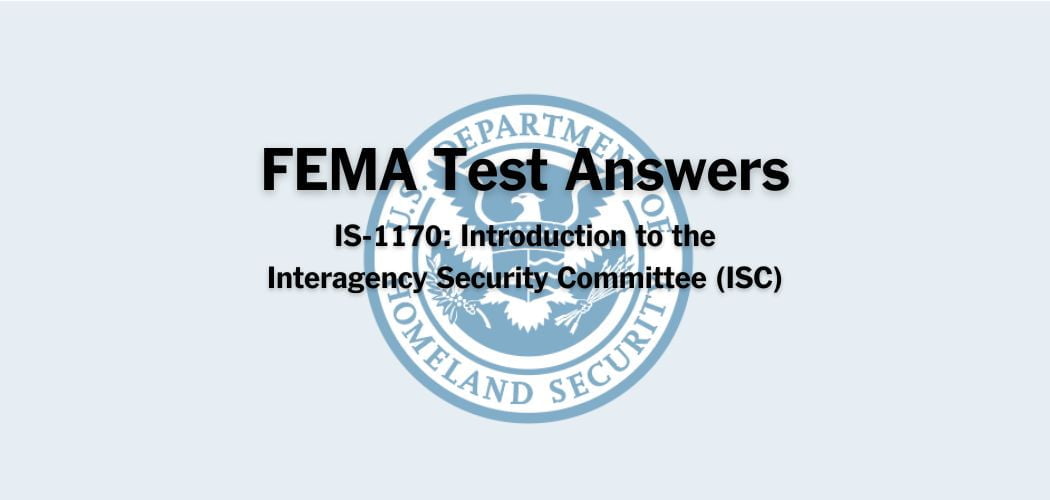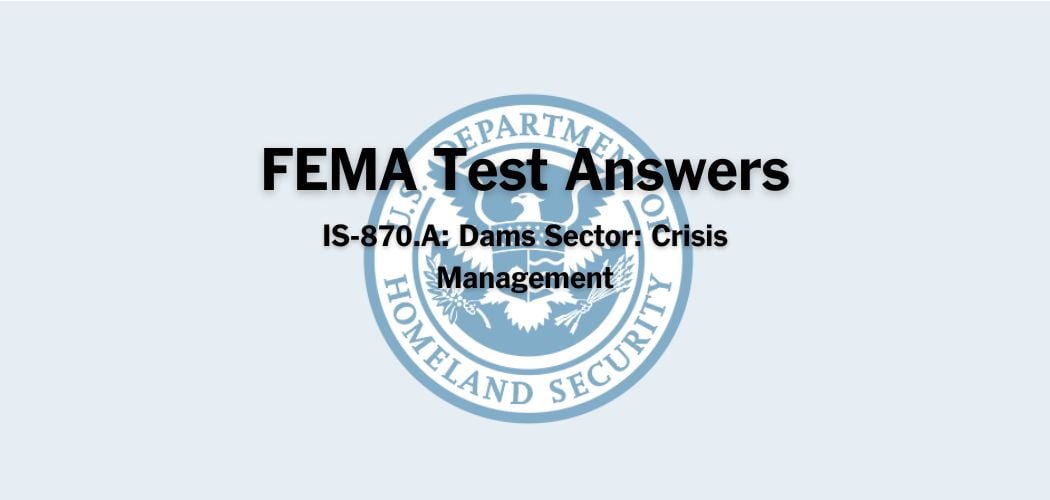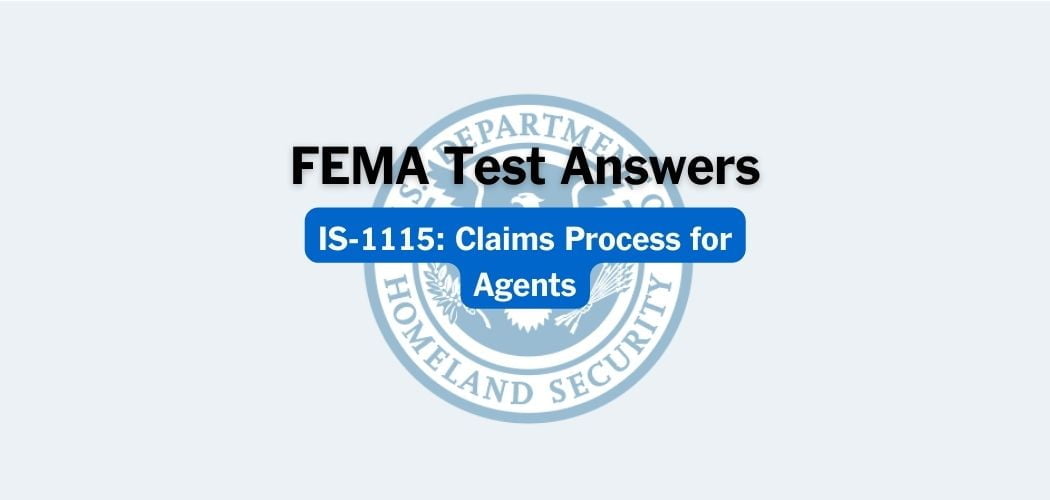Overview: The FEMA IS-905 course was published on 12/14/2022 to give people information on how to effectively respond if ever faced with an active shooter incident. Being prepared to act can make all the difference.
Objective: The goal of the IS-905 course is to make a swift and informed decision during an active shooter incident, provide essential medical treatment to those that are injured, and how to properly engage with law enforcement.
FEMA IS-905 test answers
Each time this test is loaded, you will receive a unique set of questions and answers. The test questions are scrambled to protect the integrity of the exam.
Question 1. An essential tool to use while building your individual emergency action plan for an active shooter incident is…
A. your local police or sheriff’s emergency guide
B. a copy of your building’s floor plan✅
C. your organization’s emergency action plan
D. FEMA’s Guide to Developing and Maintaining Emergency Operations Plans
Question 2. Physical rehearsals are effective ways to build muscle memory. The following is not a type of physical rehearsal:
A. Moving to a hiding place and checking to be sure the door locks from the inside.
B. Participating in a building-wide drill to practice responding to an active shooter.
C. Taking one of your evacuation routes when you leave the building for the day.
D. Imagine taking one of your evacuation routes while you are in your office.✅
Question 3. While all municipalities have access to 9-1-1 phone lines,
A. all municipalities also have text to 9-1-1.
B. some but not all municipalities have text to 9-1-1.✅
C. Federal law prevents all municipalities from having text to 9-1-1.
D. telephones should be the primary source of communication as texting to 9-1-1 centers is unreliable.
Question 4. Immediately after reaching the rally point (a location far enough from the building to safely gather), the most important thing to do is:
A. begin considering long-term care plans for those involved.
B. begin formulating notes for an after-action report.
C. account for all people who were known to be in the building.✅
D. begin contacting loved ones.
Question 5. When conducting mental rehearsals, you should do all of the following except
A. ensure the rehearsal complements your organization’s emergency action plan.
B. think through the obstacles you may face.
C. repeat your mental rehearsals.
D. vividly imagine or visualize the situation and imagine hearing the sounds you might hear during the situation.
E. focus on a singular plan and avoid thinking about alternative plans.✅
Question 6. When you are escaping, you should…
A. ensure you are mindful of potential dangers given the unique situation and select the safest route.✅
B. be mindful of the number of people that each route could tolerate, ensuring that you avoid highly trafficked routes.
C. Consider the time it would take you to use each route, as time is the most important aspect to determine your escape.
D. run past interior windows, giving you the opportunity to see any dangers as you progress to your exit.
Question 7. The best actions you can take to move quickly from denial to decisive action are all of the following except
A. determine questions to ask at the moment to be certain action is needed.
B. practice those actions through mental and physical rehearsals.
C. understand the actions you can take given the emergency.
D. decide now that erring on the side of caution is best.✅
Question 8. During an active shooter incident, when should you not be concerned with the possibility of having to fight?
A. As you are secured in your hiding location.
B. prior to reaching safety, you should always be prepared to fight.✅
C. as you run, attempting to escape a building with a known active shooter.
D. Close to the exit as you are working to escape, but not yet outside your building.
Question 9. At a minimum, to plan for an active shooter your Individual Emergency Action Plan should have all of the following except…
A. Locations of alert buttons.
B. Locations of life-saving kits.✅
C. Options to Run, hide, and fight
D. Methods for contacting law enforcement
Question 10. When engaging in decisive action, a step in the arc of survival, it is best to…
A. the likelihood of an attack is minimal, you should think twice before taking action.
B. err on the side of caution and take immediate action.✅
C. be cautious in your approach, actions can’t be taken back.
D. it is best to reach out to a trusted professional to determine your next action.
Question 11. To treat a wound to this part of the body, wipe the skin around the wound to remove any fluid and blood, and place a non-occlusive seal over the wound with the valve in the seal directly over the hole if possible.
A. Chest (involving a punctured lung)✅
B. Head
C. Leg or arm
D. Abdomen
Question 12. Following an active shooter incident, there will be many resources provided except for:
A. mental health support.
B. reunification support.
C. trained healthcare monitors encouraging you to access needed support.✅
D. family assistance.
Question 13. As you create and refine your individual emergency action plan, you should…
A. Conduct walk-throughs of your building.
B. Conduct mental rehearsals of multiple scenarios.✅
C. Consider your organization’s emergency action plan.
D. Conduct reviews of past individual emergency action plans.
Question 14. When preparing to fight, you should identify
A. objects in your desk and in your vehicle.
B. objects that are in and around your rally point.
C. objects you could use to fight in your primary workspace or in your ideal hiding spots.✅
D. objects that you could use to open locked doors.
Question 15. The best way to get the brain to perform under extreme stress during an unexpected emergency, and to move quickly through denial and deliberation to decisive action, is to…
A. have a plan that must be read to execute.
B. meditate beforehand to ensure a clear mind and enable yourself to be flexible at the moment.
C. repeatedly runs through rehearsals, both mental and physical beforehand.✅
D. team up with someone to help you both through the stressful situation.
Question 16. To ensure you are able to move through the arc of survival more quickly during an emergency, you should….
A. Study the arc of survival
B. Create an individual emergency action plan✅
C. Have a copy of your organization’s emergency action plan
D. Visualize your reactions to potential emergencies
Question 17. In order to conduct highly effective rehearsals, you should first prepare your individual emergency action plan. To develop your plan you should
A. leverage your experience conducting multiple rehearsals in other buildings to develop a dynamic plan that works in multiple buildings.
B. review the research on other active shooter situations to identify attack trends.
C. build a list of the most likely active shooter access points and study ways to evade that one attack.
D. get to know your building, consider different scenarios, and your organization’s emergency action plan.✅
Question 18. When you encounter law enforcement on the scene of an active shooter, you should do all the following except:
A. immediately lay on the ground and spread your arms and legs.✅
B. slowly put down any items in your hands such as bags, jackets, and phones.
C. do exactly as you are told so that responders can eliminate all suspects.
D. Avoid pointing, screaming, yelling, or rushing toward officers.
E. raise your hands, spread your fingers, and keep your hands visible at all times.
Question 19. You should fight only when
A. you are secured in a hiding place.
B. you can’t run and escape.
C. others’ lives are in danger.
D. you have no other option.✅
Question 20. After you have refamiliarized yourself with your building, you should begin to plan your escape routes to prepare for an active shooter situation. Which of the following should you not do when planning your escape routes?
A. consider different places you could hide along each escape route.
B. consider different scenarios and identify different locations where an active shooter might emerge, helping you connect different routes to different scenarios.
C. rehearse the quickest escape route.
D. identify the route that you feel is best, and stick with that route.✅
Question 21. To treat a wound on this part of the body, apply gentle pressure to the wound with a folded-up cloth. Do not place anything into the wound. After 1-2 minutes of gentle pressure, tape the cloth in place to keep the wound covered. Once a dressing has been applied, do not remove it.
A. Chest (involving a punctured lung)
B. Arm✅
C. Leg
D. Abdomen
Question 22. The most secure places to hide have the following in common except
A. is secured by a locking mechanism, that keeps the attacker away.
B. has furniture or objects that provide additional cover.
C. has furniture that may be used to barricade the door.
D. is secured behind a door that opens outwards towards an attacker.✅
Question 23. When your patient is conscious, how should you position them?
A. On his or her back.
B. Sitting up.
C. On his or her side.
D. In whatever position is most comfortable.✅
Question 24. Finding a place that provides cover is essential during an active-shooter situation because
A. cover creates a distraction from the shooter
B. cover ensures a partial layer of protection.✅
C. cover hides you from the attacker’s view.
D. cover protects you from bullets.
Question 25. Knowing your building is essential; when planning escape routes, you should do all of the following except
A. identify the locations you will run to after escaping the building.✅
B. identify potential dangers along each escape route, including open floor plans.
C. rely on your knowledge of the building, years of working in the same building pays off.
D. consider locations you frequent at work and identify various routes of escape from them.
E. identify doors along your escape routes that may be locked.



![[FEMA Test Answers] IS-8.A: Building for the Earthquakes of Tomorrow - Test Pinoy](https://testpinoy.com/wp-content/uploads/2021/11/fema-is-8a.jpg)